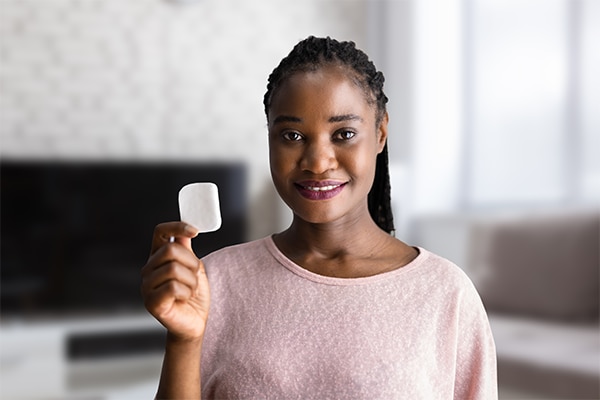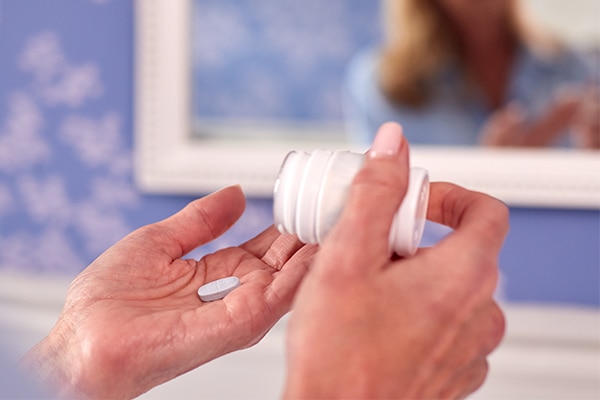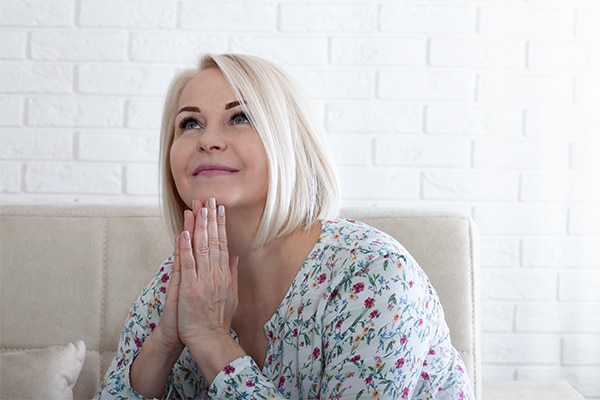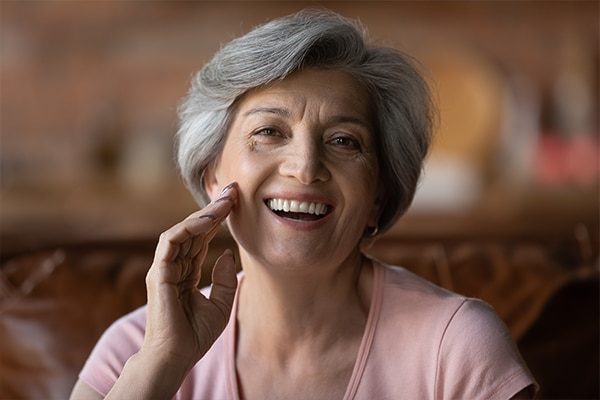Everything you need to know about HRT

Some women sail through menopause with very few symptoms, but unfortunately the majority don’t. If you’re struggling, it might be worth considering Hormone Replacement Therapy (HRT).
HRT replaces the hormones that are at lower level as you approach menopause.1
The majority of symptoms are caused by declining oestrogen levels, so HRT is prescribed to redress the balance.
How to take HRT
You need to take oestrogen to manage your symptoms. Oestrogen is known as a steroid hormone and its main role is in the growth and differentiation of reproductive issues.2
Taking oestrogen on its own can cause thickening of the lining (endometrium) of your womb, so you’ll need to take progesterone as well to prevent this happening unless you’ve had a hysterectomy.3 This is known as combined HRT.4
Oestrogen is available as:
- Tablet
- Transdermal preparations - through the skin - as a patch, gel or spray
- Vaginally (to help with vaginal dryness, by itself or alongside HRT)5
Progesterone is also a steroid hormone that is produced by the adrenal cortex and the ovaries.6 Its main role is to stimulate and regulate bodily functions such as your menstrual cycle, pregnancy and sexual desire – but in HRT it is used to protect the uterine lining.6

Progesterone is available as:
-
a tablet
-
as a combination tablet with oestrogen
-
in a combination patch with oestrogen
-
as a mirena coil. These are synthetic (man-made) products.
-
It can also be taken as a tablet called utrogestan, a natural form of progesterone. This tablet can be taken orally or is sometimes used vaginally.7
Testosterone is an androgen and is known to regulate libido in both men and women.8
It therefore may also be prescribed for low libido, and is used in addition to HRT. It comes as a gel or a cream.5
It’s reassuring to know that there isn’t a one-size fits all approach, the right dose and hormones will be prescribed for your specific symptoms and need. The way you take it also varies.
However, it’s important to highlight that HRT is not a contraceptive (apart from mirena) and you still need to use contraception. If your last period is under 50, you need it for 2 years, and if over 50, you need contraception for an extra year.9
How often to take HRT
The frequency depends on what type of HRT you are taking.
Oestrogen tablet, gels and sprays are used daily. Patches (both oestrogen only and combined oestrogen and progesterone) are changed twice a week.
The stage of the menopause affects how often you take the progesterone. When you’re still having periods, you’ll be on sequential HRT. This means you’ll have oestrogen continuously and take progesterone for half the month.10

After your periods have stopped for a year, or over the age of 53, you’ll progress to continuous HRT and have progesterone every day.
If you choose to use the Mirena coil, it delivers continuous progesterone, so you won't need more. The Mirena provides progesterone for 5 years.
Testosterone use varies depending on the product.
Your healthcare professional, such as GP, will be able to give you advice on how to use your HRT.
Other ways to take HRTIf you experience premature ovarian insufficiency or early menopause, an alternative to HRT is the combined oral contraceptive pill.11
As well as being a contraceptive, the oestrogen in the pill helps with your symptoms.
The strength of your HRT will be reviewed by your healthcare professional and oestrogen may be increased as needed to help with symptoms.
Many women suffer with uncomfortable vaginal issues such as dryness and thinning of the tissues in the genital area. If you’re one of them, you might be prescribed vaginal oestrogen in combination with HRT. It usually takes the form of a cream, pessary or a vaginal ring.
You may notice a drop in your libido during menopause – it’s one of those taboo subjects, but it’s very common and testosterone may help if HRT alone is not effective.12
Many people think of it as the male hormone, but women produce it too. As well as boosting sex drive it can promote energy levels, concentration and well-being.13
HRT risks
Some women are reluctant to take HRT because of the perceived risks, but the chances of it having an adverse effect on your health are actually very small.14
Your doctor or nurse will assess your personal and family history before prescribing it to ensure that it’s safe for you to take.
You may have heard that HRT has been linked with a slightly increased risk of breast cancer.15
This is true, but it needs to be looked at in context. There are an additional 4 cases of breast cancer per 1000 women aged 50-59 taking combined HRT (oestrogen and progesterone) per year, but 4 fewer cases per 1000 women who only take Oestrogen.16
Some types of progesterone - utrogestan - have a lower risk of breast cancer.17
Although some HRT may slightly increase your risks of developing breast cancer, it doesn’t increase your risks of dying from it. To put this in context, drinking alcohol also results in a slightly increased risk of breast cancer.18

There is also a small risk of developing a blood clot in your leg or lungs when taking HRT as a tablet, but this isn’t the case if you take it as a patch, gel or spray.20
Although taking HRT tablets (but not gels or patches) are associated with a slightly increased risk of stroke, the NICE guidelines state that starting HRT if you’re below 60 does not increase the risk of cardiovascular diseases.
It’s also important to keep in mind that the risk of stroke in women under 60 is very low anyway.14
HRT side effects
While HRT can help you manage some symptoms of menopause, you may experience the following symptoms on:
Oestrogen
- Bloating
- Breast tenderness or swelling
- Swelling in other parts of the body
- Feeling sick
- Leg cramps
- Headaches
- Indigestion
- Vaginal bleeding21
Progesterone
- Breast tenderness
- Swelling in other parts of the body
- Headaches or migraines
- Mood swings
- Depression
- Acne
- Tummy (abdominal) discomfort
- Back discomfort
- Vaginal bleeding
How can HRT help?
- It helps a wide variety of menopausal symptoms including hot flushes and night sweats, urinary issues, mood and sexual function.
- It helps to reduce the risk of osteoporosis by maintaining bone density.
- It can reduce the risk of developing heart disease when started under the age of 60.
- It may help to reduce the risk of colorectal (bowel) cancer.
- It may reduce the risk of developing Alzheimer’s disease.14,22

If you have been considering HRT, you may have come across the two terms ‘body identical’ and ‘bioidentical HRT’.
Body identical is the HRT that you will be prescribed by your GP, and it is a regulated and evidenced based product.
Some menopause practitioners offer bioidentical HRT which are precise duplicates of human hormones that are produced by specialist pharmacies and do not follow the same regulatory pathway as conventional HRT.
If you don’t like the idea of taking HRT, your GP can recommend alternative options:
- Antidepressants, such as venlafaxine, sertraline and fluoxetine may help to manage vasomotor symptoms such as hot flushes and night sweats, as well as depression and anxiety.24
- Gabapentin – this is a nerve stabiliser which may help with hot flushes and night sweats.25
- Clonidine – this is a blood pressure medication which may help with menopausal symptoms.26
In addition, Cognitive Behaviour Therapy (CBT) and lifestyle measures are hugely important and can help with hot flushes and night sweats.27
Try to get plenty of cardiovascular exercise and keep an eye on your weight. Wearing lighter clothes or layers and avoiding triggers like smoking, alcohol, caffeine and spicy foods can all help you feel more comfortable.
Black Cohosh may help relieve some menopausal symptoms.28
These products are not recommended by NICE or the BMS. 23